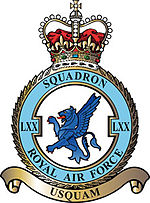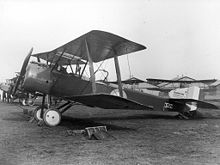- No. 70 Squadron RAF
-
No. LXX Squadron RAF 
Active 1916-1920
1920-1947
1948 - 2010Role Air Transport Garrison/HQ RAF Lyneham Motto "Usquam" (Everywhere) Equipment C-130 Hercules Insignia Identification
symbolA demi-wing lion erased No. 70 Squadron (also known as No. LXX Squadron) of the Royal Air Force most recently operated the Lockheed Hercules from RAF Lyneham, Wiltshire until September 2010.[1]
Contents
History
World War I
The squadron was formed on April 22, 1916 at Farnborough, and was equipped with the Sopwith 1½ Strutter. The squadron was posted to France, and in 1917 re-equipped with Sopwith Camels. The squadron briefly disbanded in January 1920, reforming nine days later at Heliopolis, Egypt via the renumbering of No. 58 Squadron. The squadron was equipped with the Vickers Vimy bomber.
During World War I, the squadron claimed 287 victories, and had as members nineteen aces, including Frank Granger Quigley, John Todd, Frank Hobson, Oscar Heron, Frank Gorringe, Walter M. Carlaw, George Robert Howsam, Clive Franklyn Collett, Alfred Michael Koch, Kenneth Bowman Watson, Noel Webb, Edward Gribben, and Frederic Laurence.[2]
Reformed for World War II
During the inter-war years the squadron operated various types of aircraft including; the Vernon, the Victoria and from 1935 the Valentia. With the outbreak of the Second World War the Valentias were replaced by Wellingtons during 1940. The squadron operated Wellingtons until February 1945 when it converted to Liberators. The squadron disbanded in April 1947.
Post World War II
The squadron reformed in May 1948, at Kabrit, Egypt when No. 215 Squadron was renumbered No. 70 Squadron. The squadron was equipped with Dakotas until 1950, when it re-equipped with Valettas. In 1955, the squadron moved to Cyprus and re-equipped with the Hastings. After a brief period operating Argosys, the squadron began conversion to the Hercules in 1970, and moved to RAF Lyneham in 1975, after 55 years overseas. After 35 years of operating the Hercules C1/C3 from Lyneham, the squadron disbanded in September 2010. It is expected to reform in 2014 as the first RAF Airbus A400M squadron.[1]
Aircraft operated
Dates Aircraft Variant Notes 1916–1917 Sopwith 1½ Strutter Single-engined biplane fighter 1917–1919 Sopwith Camel Single-engined biplane fighter 1919 Sopwith Snipe Single-engined biplane fighter 1920 Handley Page 0/400 Twin-engined biplane bomber 1920–1922 Vickers Vimy Twin-engined biplane bomber 1922–1926 Vickers Vernon Twin-engined biplane transport 1924-1926
1926-1934
1928-1934
1930-1935
1931-1935Vickers Victoria I
III
IV
V
VTwin-engined biplane transport 1935–1940 Vickers Valentia Twin-engined biplane transport 1940-1943
1943-1945Vickers Wellington III
XTwin-engined medium bomber 1945–1946 Consolidated Liberator VI Four-engined bomber 1946–1947 Avro Lancaster B1(FE) Four-engined bomber 1948–1950 Douglas Dakota Twin-engined transport 1950–1956 Vickers Valetta C1 Twin-engined transport 1956–1968 Handley Page Hastings C1 and C2 Four-engined transport 1967–1975 Armstrong Whitworth Argosy C1 Four-engined transport 1970–1980 Lockheed Hercules C1 Four-engined transport 1980–2010 Lockeed Hercules C3 Four-engined transport See also
- List of RAF squadrons
References
- ^ a b "LXX Squadron Stand Down". www.raf.mod.uk. Royal Air Force. 10 September 2010. http://www.raf.mod.uk/raflyneham/newsweather/index.cfm?storyid=FABEEAE3-5056-A318-A86C009AF03E11F9. Retrieved 4 October 2010.
- ^ http://www.theaerodrome.com/services/gbritain/rfc/70.php Retrieved 17 February 2010.
- ^ Jefford 1988, page 46
- Jefford, C.G. (1988). RAF Squadrons. Airlife Publishing Ltd. ISBN 1 85310 053 6.
External links
- "70 Squadron". Royal Air Force.
- http://www.rafweb.org/Sqn066-70.htm
Currently active Inactive 1 · 4 · 10 · 13 · 20 · 21 · 23 · 25 · 26 · 34 · 35 · 36 · 37 · 38 · 40 · 42 · 43 · 44 · 46 · 48 · 49 · 50 · 52 · 53 · 55 · 58 · 59 · 61 · 62 · 63 · 64 · 65 · 66 · 67 · 68 · 69 · 70 · 71 · 73 · 74 · 75 · 76 · 77 · 79 · 80 · 81 · 82 · 83 · 85 · 86 · 87 · 88 · 89 · 90 · 91 · 92 · 93 · 94 · 95 · 96 · 97 · 98 · 102 · 103 · 104 · 105 · 106 · 107 · 108 · 109 · 110 · 111 · 112 · 113 · 114 · 115 · 116 · 117 · 118 · 119 · 120 · 121 · 122 · 123 · 124 · 125 · 126 · 127 · 128 · 129 · 130 · 131 · 132 · 133 · 134 · 135 · 136 · 137 · 138 · 139 · 140 · 141 · 142 · 143 · 144 · 145 · 146 · 147 · 148 · 149 · 150 · 151 · 152 · 153 · 154 · 155 · 156 · 157 · 158 · 159 · 160 · 161 · 162 · 163 · 164 · 165 · 166 · 167 · 168 · 169 · 170 · 171 · 172 · 173 · 174 · 175 · 176 · 177 · 178 · 179 · 180 · 181 · 182 · 183 · 184 · 185 · 186 · 187 · 188 · 189 · 190 · 191 · 192 · 193 · 194 · 195 · 196 · 197 · 198 · 199 · 200 · 201 · 204 · 205 · 209 · 210 · 211 · 212 · 213 · 214 · 215 · 217 · 218 · 219 · 220 · 221 · 222 · 223 · 224 · 225 · 226 · 227 · 228 · 229 · 231 · 232 · 233 · 234 · 235 · 236 · 237 · 238 · 239 · 240 · 241 · 242 · 243 · 244 · 245 · 246 · 247 · 248 · 249 · 250 · 251 · 252 · 253 · 254 · 255 · 256 · 257 · 258 · 259 · 260 · 261 · 262 · 263 · 264 · 265 · 266 · 267 · 268 · 269 · 270 · 271 · 272 · 273 · 274 · 275 · 276 · 277 · 278 · 279 · 280 · 281 · 282 · 283 · 284 · 285 · 286 · 287 · 288 · 289 · 290 · 291 · 292 · 293 · 294 · 295 · 296 · 297 · 298 · 299 · 353 · 354 · 355 · 356 · 357 · 358 · 360 · 361 · 510 · 511 · 512 · 513 · 514 · 515 · 516 · 517 · 518 · 519 · 520 · 521 · 524 · 525 · 526 · 527 · 528 · 529 · 530 · 531 · 532 · 533 · 534 · 535 · 536 · 537 · 538 · 539 · 540 · 541 · 542 · 543 · 544 · 547 · 548 · 549 · 550 · 567 · 569 · 570 · 571 · 575 · 576 · 577 · 578 · 582 · 586 · 587 · 595 · 597 · 598 · 618 · 619 · 620 · 621 · 622 · 623 · 624 · 625 · 626 · 627 · 628 · 629 · 630 · 631 · 635 · 639 · 640 · 644 · 650 · 651 · 652 · 653 · 654 · 655 · 656 · 657 · 658 · 659 · 660 · 661 · 662 · 663 · 664 · 665 · 666 · 667 · 668 · 669 · 670 · 671 · 672 · 673 · 679 · 680 · 681 · 682 · 683 · 684 · 691 · 692 · 695
Australian Flying Corps (AFC) units attached
to the RAF during the First World WarCommonwealth air force units attached to
the RAF during the Second World War.Squadrons formed from non-Commonwealth
personnel during the Second World WarArgentineBelgian349 · 350CzechoslovakDutchFrenchGreek335 · 336NorwegianYugoslavRoyal Auxiliary Air Force Special ReserveAuxiliary Air ForceFleet Air Arm of the RAF (1924–1939) Categories:- Royal Air Force aircraft squadrons
- Military units and formations established in 1916
- 1916 establishments in the United Kingdom
Wikimedia Foundation. 2010.

